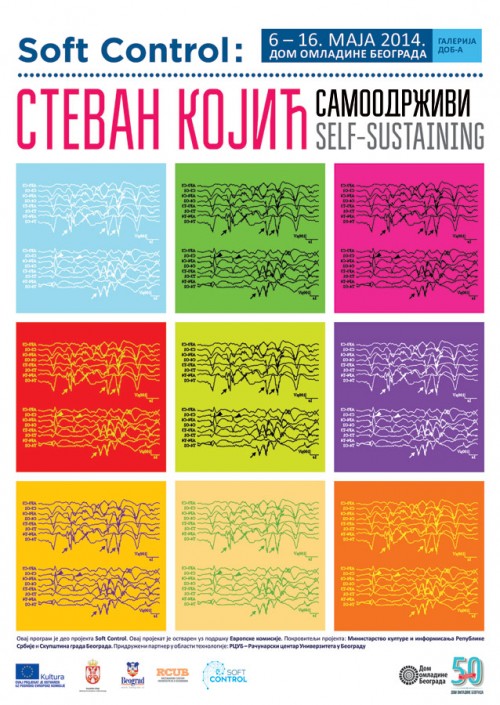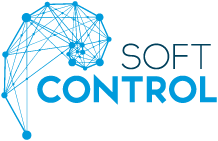
SOFT CONTROL: Stevan Kojić, SELF-SUSTAINING
The Self-sustaining System of Force and Absurdity
The concept of the exhibition continues my previous research on the flow of information through various media, and the possibility of converting visual impulses into audio or motor signals, but this time but this time by utilizing an electroencephalograph, a device that detects brain waves and converts them into audio-visual impulses. At the same time I will examine the possibility of using satellite signals of meteorological satellites orbiting around the Earth (sent as radio signals to Earth) through radio signal receivers available on the Internet. This way the hybrid structured installation will enable intersecting two types of waves brain waves that we „broadcast in a sense”, and radio waves that surround us.
For this occasion, the created quasi-laboratory space station will work on the principle of interactivity and direct participation of the audience in the process of using waves and vibrations for converting audio into visual or motor signals and vice versa.
Stevan Kojić
Stevan Kojić – User Interface Art
Actively consuming contemporary technology through a graphical user interface [1], we partly control the flow of information and its safety As a result of limited control over user interfaces, we often find ourselves confronted with information overload. We don’t find the time for processing-thinking, nor time for our own reflections. Thus, we automatically consume information without understanding its wider context and truthfulness. Our virtual copy, which is born in the graphical user interface, becomes our “new reality”, easy for manipulation and control.
Through art, science and technology, Stevan Kojić points to everyday life in a graphical user interface. His planned out systems-experiments transform the gallery space into a laboratory. Here, the visitor is actively participating, partly influencing the changes in the signals-information.
Kojić’s new “Self-sustaining” system continues his previous research based on the flow of signals through various media and examines the possibility of transforming the visual impulse into an audio or motor signal. The central part of the system is the electroencephalograph (EEG). It registers brain activity from the visitor’s scalp with the help of electrodes. Obtained values of brain activity are then passed to Arduino (open-source software and electronics) and a computer, transposing them into sound and video animation, and using them for controlling vibrating motors. The visitor sees, hears and feels the changes that are a direct consequence of his brain activity. During the process of watching, new changes occur in brain activity, which the system registers and continues to transform signals that control the visual, audio and motor parts of the system. Signal values are more balanced while not registering brain activity, and more dynamic when the visitor is an integral part of the system. Brain waves intersect with radio waves received by radio receivers available on the Internet. They receive signals from meteorological satellites orbiting around the Earth. The first type of waves we broadcast ourselves, while the second type surround us. Signals circulating in this hybrid system mutate, disappear and reappear, trying to convince us that the system is self-sustaining. Caught up in this electronic “vicious circle”, we often aren’t sure what the purpose of the obtained information is, what the system is used for, besides us partly influencing it, i.e., that which it produces. Since a self-sustaining system is not possible, we realize we are brought into an absurd state, similar to the one we fall into every day with information overload. The absurdity is highlighted by the idea that the system emulates an organism “whose only purpose is its own existence [2]”.
Even though it reminds us of a science laboratory, Stevan Kojić’s hybrid installation does not serve to discover a scientific truth, it exerts its impact through the domain of comprehension of art by a visitor. It points to a contemporary position in a user tailored interface system in which we create our virtual identities.
[1]Â Graphical User Interface – GUI (colloquial: GUI is a type of user interface that allows users to interact with electronic devices through graphical icons and visual indicators such as secondary notation.
[2] Taken from the interview with Stevan Kojić “Početak ne leži u tezi, već u dilemi”, for the webzine www.supervizuelna.com.
STEVAN KOJIĆ (1973, Kikinda) received a B.A. and an M.A. degree in sculpture from the Faculty of Fine Arts in Belgrade. He is an associate professor at the Department of New Fine Arts Media at the Academy of Arts in Novi Sad and the Academy of Fine Arts in Trebinje. His main interests are researching relationships between art, society, science and technology through relations between the analog/digital, biology/technology, ecology/economy, low-tech/hi-tech, open/closed systems, time/space, the virtual/real, etc.
Contact: kojicstevan@gmail.com, www.stevankojic.com
ABOUT STEVAN KOJIĆ:
Remember those infinite machines from cartoons, where one action leads to another, the second to the third and so on? Stevan Kojić constructs something similar, but he uses contemporary technological methods and gadgets in combination with objects from everyday life. We will be talking in regard to the recently held exhibition “The Self-sustaining System of Absurdity – еco-technological-bio-social habitat” held at the 12Hub Gallery.
An introduction to an interview led by Žolt Kovač for www.supervizuelna.com
…The technological meets the biological in an altogether new way in Stevan Kojić’s installation “The Self-sustaining System of Absurdity” (2010). Here, through the cyclic travel of information between bonsai trunks and electronic devices, he asks (maybe rhetorically) if there is a purpose to the constant recycling of meaning and knowledge, and the infinite reinterpretations of cultural, social, political and economic information.
Ena Hodžić, from the catalogue “Device Art 4.012 – Machines, Robots and Boiled Eggs”, Kontejner, Zagreb, 2012
… we see Stevan Kojić’s need for creating a system that doesn’t strive to discover great scientific ideas and truths that real science laboratories insist on, but strives to enable freedom to act, to simplify and repurpose existing, traditional socio-artistic systems. Here we see a noticeable orientation of the artist toward utilizing open source hardware and a do-it-yourself philosophy. This practice is characteristic for artists in the West known as makers, whose basic concepts of work are experiments in multidisciplinary projects.
Sanja Kojić Mladenov, for the exhibition: “Stevan Kojić: Unstrategic intelligence”, the Fine Arts Salon of the Cultural Centre of Novi Sad, Novi Sad, October 2012
This “laboratory” with its absurd “experiments”, that is conceptually mostly based on the principles of ecotechnology, indirectly points to the absurdity of today’s relations in society and makes one think if man should break loose from the system, return to himself and his dignity and reestablish his union with nature by recognizing the potentially mutual positive relationship between nature and technology, for mutual benefit, and a wellbeing for mankind. As long as art is in favor of consciousness, the more artists cross boundaries — the better. Stevan Kojić’s exhibition “The Self-sustaining Systems of Absurdity” does just that, and in an unobtrusive and very constructive way.
Sunčica Lambić – Fenjčev, for the exhibition “The Laboratory of Absurdity” held at the Contemporary Gallery in Zrenjanin
About the SOFT CONTROL Project (www.softcontrol.info)
SOFT CONTROL – Art, Science and the Technological Unconscious (EU)
Dom omladine Belgrade is part of the wide range European project “Soft Control — Art, Science and the Technological Unconscious” that will be realized during 2012–2015 through the cooperation of 9 partners from 7 countries. During this period there will be more than 8 symposiums, 16 solo art exhibitions/installations, over 40 talks with artists, 7 big residency programs for artists and scientists, 4 group exhibitions, 8 workshops, over 30 lectures, 12 group exhibitions, 7 performances, and many artist and project exchanges which will result from basic project activities. The goal is to make Soft Control a multi-annual cultural project with the mission to introduce science labs to a wider audience, starting from artists and experts, to various educational entities, going further to include the widest public. Through this project and the cooperation with its European partners, Dom omladine Belgrade will present to the domestic public the most important Belgrade artists from this field. www.softcontrol.info
Partners and co-organizers of the Soft Control project: Multimedijalni centar KIBLA, Maribor, Slovenia (project leader and coordinator); Hangar (FundaciĂł Privada AssociaciĂł d’ Artistes Visuals de Catalunya), Barcelona, Spain; Muzej suvremene i moderne umjetnosti, Rijeka, Croatia;
Galerija O3ONE, Belgrade, Serbia; Media Space RIXC, Riga, Latvia; CIANT (International Centre for Art and Technology), Prague, Czech Republic; Faculty of Fine Arts, University of Porto, Porto, Portugal; KGLU, Slovenj Gradec, Slovenia; and DOM OMLADINE BELGRADE, Belgrade, Serbia.
The Project Team:
Dušana Nikolić Radošević, project editor
Ivan Stanić, curator of the exhibition, art historian
Milica Ševarlić, public relations
Jakov Ponjavić, design
Marko Radojković, executive producer
This exhibition is part of the SOFT CONTROL project. The project was realized with the support of the European Commission. Sponsored by: the Ministry of Culture and Media of the Republic of Serbia, and the Assembly of the City of Belgrade. Associate partner in the field of technology:Â the Computer Center of the University of Belgrade. We thank the School of Electrical and Computer Engineering of Applied Studies in Belgrade for our cooperation.
